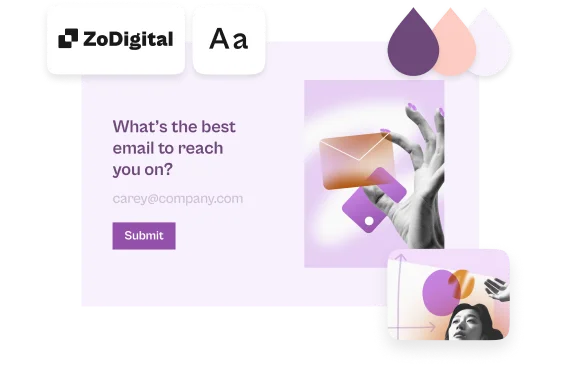Personalize selling with product rec quizzes 👉
Get free ebookTOOLS
NEW
- Enterprise
- Pricing

Customer retention strategies: 4 Steps To Profitability
Boost your customer retention rate and become more profitable—just by focusing on the customers you already have
Go into your purse or wallet. Maybe even the back of your phone case if you’re like me.
I bet you there’s a worn loyalty card in there.
That right there is a basic customer retention strategy. Giving people an incentive to return and spend money.
When you dive into the statistics surrounding repeat custom and brand loyalty, you start to wonder why people wouldn’t invest their time and money into customer retention.
Returning customers account for around a third of online sales. Big number, right? But too many companies don’t realize the importance of customer retention—a.k.a “user retention.”

These organizations lose around 20% of their existing client base because they fail to nurture existing relationships. One in every five customers will slip through the cracks—and probably never come back.
In many cases, the customer retention rate of companies suffers because of an obsession with chasing new leads.
According to a Yotpo report on retention rates, returning customers spend around three times more on e-commerce websites than one-time shoppers. These are delighted customers who received a great product or service, maybe even both.
They have placed their trust in companies that have delivered, and in any business—that’s as good as money in the bank.
Too many businesses today are neglecting their loyal followers in favor of attracting new customers and driving growth. They are making the mistake of taking their customers for granted when they make their forecasts and sales projections.
Even the most accomplished managers and marketing professionals are assuming that a happy customer is a customer for life. But really, that couldn’t be further from the truth.
A new type of customer
The modern consumer is more ruthless than ever. And why shouldn’t they be?
There is more choice out there than ever before. If Carol feels like her favorite online clothing store is favoring new customers with its discounts and special offers, she’ll do exactly what you’d expect her to do. Leave.
Carol will become a new customer somewhere else—somewhere that gives her points for every purchase, and free shipping at the weekend.
Having a comprehensive customer retention solution in place is every bit as important as winning new customers. After all, retaining the loyalty of people who have already bought into your brand is a lot easier and cheaper than finding, persuading and closing new customers.

Why you need to boost your customer retention rate
Of course, you need to find new customers in order to grow your business — but this can only be one half of your organization’s marketing strategy. As well as providing you with a steady and reliable income, your existing customer base is actually part of your marketing team.
Who better to shout from the rooftops about your company than the people who know and trust it? Through sheer word of mouth, they’ll convert skeptics into fans—simply by talking to their friends and family about you. But, they’ll only do this if you’re exceeding their expectations on a regular basis.
Step back and think about what it is you’re trying to do with your marketing campaigns. You’re trying to educate, build trust and develop confidence in your products or services. When you have a happy customer on your hands—it’s very much a case of job done.

The people who buy from you regularly know they can trust you to deliver. Their hard-earned is in safe hands, and that’s good to know at a time when so many sly companies treat consumers very badly.
But the worst thing you can do is take this trust for granted. Continue speaking directly to your loyal customers, and they’ll continue coming back for more. They’ll help you to build a solid foundation through repeat purchases and goodwill.
Neglect your customers, however, and you’ll hurt their feelings. They’ll look for love elsewhere. And like any spurned lover, they’ll bad-mouth you at every opportunity they can. On the bus. At Walmart. Everywhere.
Four customer retention strategies that work
Just a 5% increase in customer retention can increase profitability by up to 75%—according to Bain and Company. If you can get retention right, you won’t only build a solid foundation for your business’s future, you’ll also secure the sales growth that every business needs.
By implementing a few proven customer retention strategies, you can ensure more of your existing customers remain happy, loyal, and liberal in their spending.

1. Reward your customers with special offers
Why do so many big companies reserve all of their money-saving love for prospective customers?
This simply makes existing customers like Carol jealous—and that’s never a healthy thing for a loving relationship.
When you launch a new discount or incentive designed to attract new customers, think about how it’s going to make your existing customers feel. Invariably, such a move will backfire unless you’re spreading the love around evenly.
If your offers or incentives aren’t appropriate for existing customers, create some that are. Market both initiatives at the same time, and do so in a way that recognizes just how much you value your existing customer relationships.
For example, imagine you’re running an incentive to attract new customers to an online shoe store. To get people to sign up as a registered customer, you’re offering a massive 25 percent of first purchases. At the same time, you could offer your existing customers a BOGOF deal—smiles all around.
Make your offers time-limited, so customers have to purchase their qualifying products within the time-frame of your new customer promotion.
Sometimes, simply letting your existing fans and followers know you’re thinking of them is enough to retain and cultivate the goodwill you’ve already developed.
2. Leave the hard-sell tactics to the used-car salesperson
Before the internet, we didn’t have access to the enormous amount of information that we now have at our fingertips. We relied on the integrity and professionalism of retail and sales professionals when making first-time purchases.
As a result, shameless companies—and there were a lot more of them before the digital age—would make the most outrageous claims in order to close a sale. And if they didn’t work, pressure tactics and fear were used to seal the deal.
But thanks to the Internet, the average consumer is more informed than ever before. Pressure selling is nearly always counterproductive these days—even more so when it’s directed at existing customers.

Above everything, consumers want to be informed and educated, as this is the only way they can be sure that they’re spending wisely. Yeah by all means, offer product recommendations, but do so in a way that communicates relevant benefits.
For example, imagine you’re selling laptops online. You had a conversation with an existing customer a year ago about gaming laptops, during which the customer told you that sound quality and the latest 4K screen technology were priorities.
At the time, manufacturers weren’t delivering what the customer wanted. But you’ve just received a shipment of some state-of-the-art laptops that meet all of the customer’s needs. You reach out—bringing up what you spoke about last year—and list all of the relevant specifications associated with the new product.
In this instance, you’re not making bold claims about how you’re going to change the customer’s life. You’re not making an unsolicited or spurious attempt to sell. You’re actually providing exceptional service—as well as giving the customer valuable information.
Whether your efforts secure a sale or not, they definitely won’t be forgotten the next time that person decides to invest in a new laptop. Simply by being an honest, helpful and thoughtful human being, you can retain customers.
3. Welcome complaints as the marketing diamonds they are
Sorry, what? Right—hear me out here.
Too many companies and marketing professionals dread customer complaints. They don’t realize just how valuable negative feedback can be in terms of customer retention and product development.
It might surprise you to know that just 1 in 10 unhappy customers complain about a bad experience. The vast majority simply decide that once bitten, twice shy. They won’t just boycott your company, they’ll just tell the world what went wrong and look for fellow boycotters to join their cause. Which is worse than a silent shun.
But when someone takes the time to complain, it’s mostly because they care about the company and the products it provides. You actually get to know what went wrong when this happens. And, more importantly, you get the opportunity to put things right.

Strangely, complaints from existing customers are often more productive than indifference. If a service or product is just okay, the customer simply gets on with their life. But if something went awry and you’re told about it, you get the chance to exceed the customer’s expectations.
If you deal with a complaint in a way that completely turns the situation around, there’s a good chance that customer will come back to you in the future. A level of trust has been developed that simply wouldn’t have been possible if the complaint hadn’t been made.
The moral of this tale? Don’t wait for complaints—actively seek them. Send out a satisfaction survey or churn survey to get feedback that you can work with.
4. Reactivate and retain customers
Maybe you sold a lawnmower to a guy in California two years ago. What have you sold to him since? Did you reach out and ask for feedback on the product? Did you offer practical advice on how to use the lawnmower or offer suggestions on complementary gardening equipment?
Whether your lawnmower was a designer dress or some expensive jewelry, you’re not alone when it comes to forgetting about customers the moment a sale goes through.
The chances are you have hundreds of “dormant” customers that never hear from you anymore. Yet between 25 to 60 percent of them would be willing to listen to you if you simply reach out in a constructive and value-led way.

Use CRM software or your own records for online customer retention, but make sure your messages are sincere and helpful. Reactivate old relationships with a customer satisfaction survey, and rejuvenate them through special offers, educational communications or just some good, old-fashioned reminiscing.
Make contact with your inactive customers through online questionnaires. Understand what these consumers want from you, and why they haven’t been all that active recently. Once you know what your customers expect, you can work on giving them it—and develop an effective way of measuring customer retention going forward.
How to retain customers—treat them like people
If you know people, you can increase customer retention. You see, it’s all about empathy and human relationships. Holding onto loyalty and goodwill isn’t rocket science, it’s about trust and respect—just like any long-term relationship.
How you ask is everything.
How you ask is everything.


